PRINCETON, NJ -- President Barack Obama's job approval rating has been steadily declining over the past several months at the same time that the Dow Jones Industrial Average has been steadily increasing. This inverse relationship between job approval and the stock market is not a common pattern with recent presidents. In fact, Gallup's analysis of job approval ratings and the Dow going back to 1977 finds few sustained periods where the Dow and presidential approval were strongly related (either positively or negatively).
Even for Obama, the current pattern is only recent. In the early months of his administration, Obama's job approval was positively related to the Dow, rather than negatively related, as is the case currently. (The accompanying graph, and all other graphs in this story, displays Dow closing values and presidential job approval ratings indexed to the respective averages for each presidential administration. The Dow figures represent the closing averages for the first day of each poll, or the most recent day before the poll began if the stock market was closed on the day the poll began.)

For the first several months of the Obama administration, through mid-June, Obama's approval rating and the Dow were not inversely related, as has been the case more recently. Although the Dow varied more than did Obama's job approval rating, the two were moving broadly in the same direction.
Things changed at roughly the end of June, when the Dow began a steady climb, while Obama's approval rating trended the other way. It is this recent inverse relationship that has caused commentators such as CNBC's Jim Cramer to speculate that the drop in Obama's job approval rating is causing investors to bid up stocks because of their belief that a less powerful Obama is good for business. However, if this is indeed what is happening, it should be noted that it has occurred through a fairly small segment of the Obama administration's time in office so far.
Further, such relationships have a high probability of being coincidences, rather than indicators of a direct causal link, although the longer this relationship is maintained, the more likely it would seem that the two are directly related.
The current speculation that stock-market changes and Obama's job approval rating are somehow conjoined raises the question: Has this been seen before? A Gallup review of the five presidents prior to Obama shows that there is no clear or consistent relationship between job approval for these presidents (Democrat or Republican) and the Dow.
Jimmy Carter
There was no consistent relationship between public perceptions of Jimmy Carter's job performance and how the stock market performed. The Dow Jones average was essentially flat during Carter's presidency, while his approval rating generally waned during his four years as president, aside from a spike in late 1979 after U.S. hostages were seized in Iran. Carter's term was marked by some of the more challenging economic times of the post-World War II era -- resulting in his generally low overall job approval ratings -- but the Dow remained flat for most of his term, rather than declining. The patterns evident in the administration of this Democratic president, in other words, show little relationship to the pattern seen in the current Democratic administration.
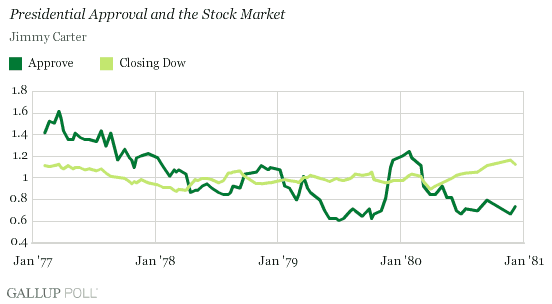
Ronald Reagan
Reagan took office in a down economy, and in the early phases of his presidency the Dow stayed flat, while Reagan's high initial approval ratings declined as unemployment continued to rise. Beginning in mid-1982, the Dow began to rise slowly, as did Reagan's approval rating in early 1983 -- presumably as Americans sensed the economy turning around. In the latter part of Reagan's presidency, the Dow continued to rise but Reagan's approval rating sank as the Iran-Contra scandal erupted. Reagan's approval ratings were relatively unaffected by the Black Monday tanking of the stock market in October 1987. During 1988, both the stock market and Reagan's approval rating showed modest gains. In summary, during the Reagan administration as a whole, there was not a consistent pattern of correlation between the president's job approval ratings and the Dow.
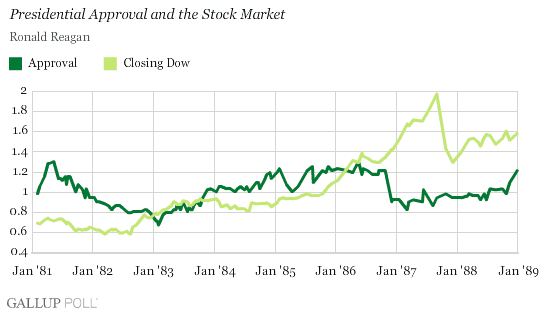
George H.W. Bush
George H.W. Bush took office during generally good economic times, and in the early part of his presidency, both his approval rating and the stock market rose. The threat of war with Iraq and rising gas prices caused both to tumble in the latter part of 1990. Bush enjoyed a tremendous rally in support when war with Iraq commenced in early 1991. The stock market also rose, but much less sharply. Even though the country was in the midst of an economic recession in late 1990 and early 1991, the stock market did not show much negative momentum during this time. However, that recession clearly took its toll on public support for Bush, as his approval rating slid throughout 1992 and did not recover until after he was voted out of office that November.
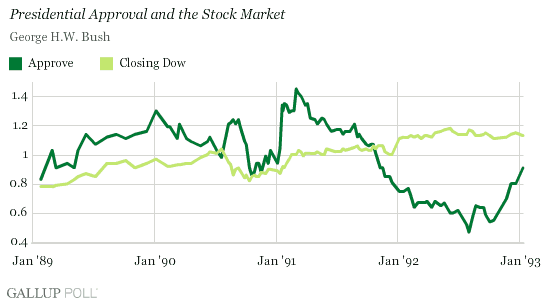
Bill Clinton
Public approval of Bill Clinton was fairly flat for the first three years of his presidency, averaging just under 50% from 1993 through 1995. At the same time, the Dow Jones Industrial stocks saw modest growth in 1993, no growth in 1994, and substantial growth in 1995. Hence, on its face, at this stage of Clinton's first term, there was no clear relationship between his approval ratings and the performance of the Dow.
The Dow began to rise at the very end of 1994 (timed, coincidentally or not, with the election of a Republican majority in both houses of Congress) and by 1995 was rising at an extremely fast clip. The Dow continued to surge almost unabated through the middle of the dot-com boom in 1998.
Across this period, Clinton's approval rating saw gradual improvement, averaging 56% in 1996, 58% in 1997, and 64% in 1998 -- almost certainly helped by the strong economy. On Aug. 3, 1998, the Dow plunged 300 points in reaction to an escalating Asian financial crisis. Yet Gallup saw virtually no change in Clinton's approval ratings at this time, as they held in the mid- to low 60s. The stock market recovered and experienced another year of sharp growth in 1999. Yet, by this time, Clinton's approval rating had dipped slightly, averaging 61% for the year. Both the Dow Jones index and Clinton's approval ratings were flat in 2000 -- suggesting that the Dow was not dampened by a change in Clinton's ratings, nor were Clinton's ratings hurt by the sluggish Dow.
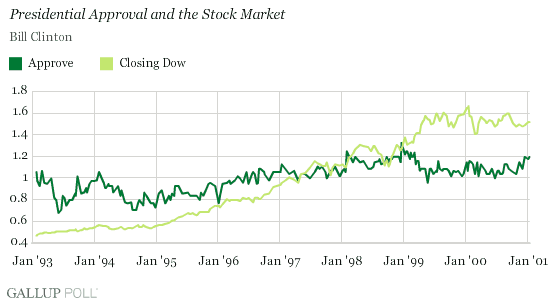
George W. Bush
George W. Bush's presidency was marked by periods when his approval rating ran parallel to the Dow (the two rose or fell together), and periods when the two moved in different directions.
At the beginning of Bush's first term in 2001, both the Dow Jones Industrial Average and Bush's approval ratings were fairly flat -- a generally acceptable condition for a president above 50% approval, but not the ideal trajectory for U.S. stocks. The Dow was dampened early on by the dot-com crash that was underway, and later by growing evidence that the U.S. was entering a recession. By early September, the weight of economic concerns seems to have helped push Bush's approval rating down to 51% at the same time that the market was sinking.
This link between Bush's approval rating and the economy/stock market may very well have continued and deepened had it not been for the events of Sept. 11. Bush's job approval score skyrocketed (to 90%) in the aftermath of the terrorist attacks, the Dow initially plummeted, and the two measures moved in opposing directions for most of the next six years.
Bush's approval rating gradually descended after his huge rally, and, dampened by mounting public opposition to the Iraq war, reached the low 30s by June 2007. Between mid-2007 and September 2008, Bush's job approval line largely flattened out in the low 30s (with occasional dips below 30%).
While Bush's stock was sinking, the Dow Jones Industrial Average was climbing. Between March 2003 and October 2007, the Dow nearly doubled, from about 7,700 to over 14,000. At this point, the Dow began to falter, and gave up more than 2,000 points over the next year (at the same time that Bush's approval rating held steady). The mostly downward path of the Dow continued until September 2008, when -- in response to the failure of Lehman Brothers and AIG in mid-September -- it lost more than 20% of its value in the span of one month, bottoming out below 8,500.
Bush's approval rating was pulled below 30% in late September 2008 and fell to a record-low 25% in October. These ratings could readily be attributed to the economic crisis befalling the country at that time, of which the tumbling stock market was the most dramatic symptom. Although the stock market fell further in November, it rebounded slightly after that, as did Bush's approval rating at the end of his term -- finishing above 30%.
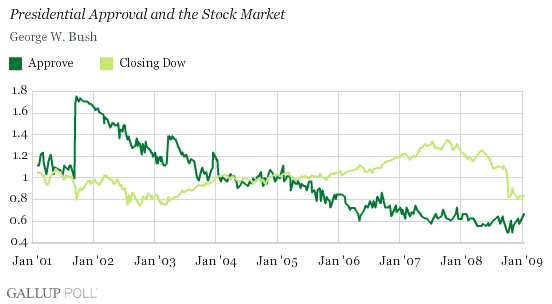
Implications
A wide variety of factors affect presidential job approval ratings, and a similarly wide array of variables are responsible for the rising and falling of the stock market. It is possible that awareness of a president's popularity could affect how people relate to the stock market, or that awareness of changes in the stock market could affect how people view the president. But clearly, many other factors could influence trends in both measures, including the very real possibility that what appears to be a relationship between the two is merely a coincidence.
At times, history makes it appear that the Dow could be a driving factor behind Americans' ratings of their president rather than the other way around. Thus, in Bill Clinton's later years, as noted above, it is certainly possible that the escalating Dow was in part responsible for the fact that his approval ratings stayed high throughout the Monica Lewinsky scandal and subsequent impeachment process.
Some observers have presumed the opposite in the current situation, however -- that Obama's approval ratings are driving the Dow; i.e., that investors perceive the policies Obama is pushing as inimical to a healthy business environment for the healthcare industry, and that his falling approval ratings thus suggest a lower probability of his programs' passing and that, in turn, leads to bidding up the market. However, this does raise questions about why Obama's job approval and the Dow were positively correlated in the first few months of the year, when the administration was advancing other big government programs related to the stimulus package, banks, and auto companies.
In any case, Gallup trends suggest no systematic pattern by which Democratic presidents (who may be viewed on Wall Street as more anti-business than Republicans) find their job approval ratings inversely related to job approval, nor a consistent pattern by which Republican presidents find a positive correlation.
More generally, from president to president, and from time period to time period within presidencies, the market and job approval ratings have moved in widely varying directions, displaying no systematic relationship.
